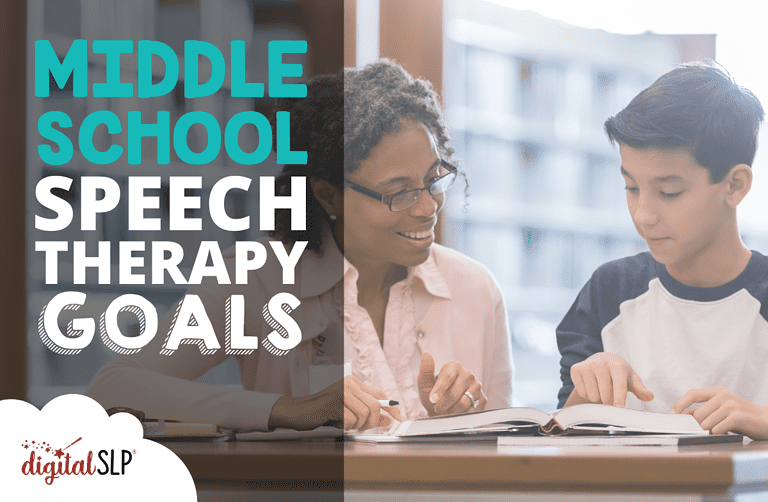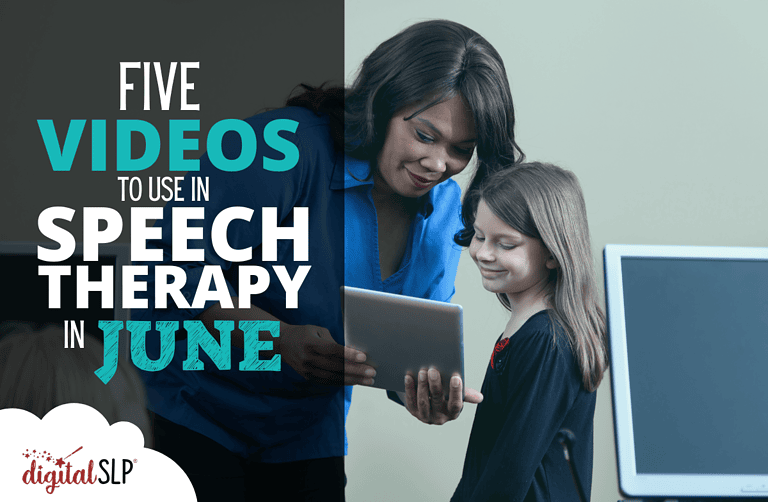This post contains affiliate links for which we may receive compensation at no additional cost to you. Click here to read our full affiliate policy.
April showers bring new video recommendations! This month’s set is an eclectic mix of art, science, sign language, and unicorns.
Just a quick reminder: I watched all of these videos and found them to be worthwhile, but everyone’s needs are different, so please preview any video before sharing it with students.
Let’s press play!
Length: 3 minutes
Ages: Preschool–3rd grade
With spring in full swing, it’s a great time to learn about plants! In this charming video, loveable monster Grover tries to care for his potted plant by giving it soil, sun, and . . . pizza. His gardening gaffes will amuse students and inspire discussions about a variety of science concepts.
Use these ideas to help your caseload’s communication skills grow:
- Adjectives: Grover loves adjectives, describing himself as “cute, furry, blue and green-thumbed.” Students could track all of the adjectives, or generate additional words to describe Grover (or anything else in the video).
- Retell and sequencing: Students could name the steps Grover takes in the video (and the outcomes that result).
- Social communication: Grover is very literal in his interpretation of what it means to “feed” a plant, and he’s confused when his plant doesn’t thrive. Students could identify the root (pun intended!) of this misunderstanding, and think of a kindhearted way to explain the situation.
- Wh-questions: This short video is full of straightforward wh-question practice opportunities for young learners. They could talk about what plants need to live, and why the plant wilts when it doesn’t get enough water.
- Extension: Grover’s antics pair well with the kid-friendly nonfiction book Cooking with Sunshine: How Plants Make Food.
Length: 3 minutes
Ages: 9th–12th grade
This is three powerful videos in one: it’s a guide to creating slam poetry, it’s a moving story about a student finding his voice, and it’s a poem in itself. When you add the spine-tingling narration and striking animation, this gem from TED-Ed becomes unforgettable. (It’s challenging and explores painful themes, so this one is definitely for older students.)
You could use this video to celebrate National Poetry Month, or to work on many other skills with your students, including:
- Figurative language: Poetry is often a rich source of figurative language, so it’s no surprise that this video has gorgeous examples of metaphors, similes, and personification. Some of the standout lines include “Take a memory; explore it like a new land,” and “The sun’s joy melts snow.”
- Personal narrative: For students who need a new approach to personal narratives, slam poetry might be energizing (and this video provides a poignant model to follow)!
- Executive function: The directions in this video are straightforward but not easy, offering an opportunity to take on an engaging multi-step project.
- Vocabulary: There are a number of vivid verbs in this video, including “abandon,” “rattle,” “quiver,” “pulse,” “trace,” and “fling.”
- Extension: Video creator Gayle Danley writes that when we teach students about poetry, we “teach them how to access the words waiting within them” (which sounds a lot like what we do as SLPs!). If your students are moved by this brief encounter with spoken word poetry, they may want to dive into the genre, especially work from young writers with organizations like Youth Speaks. (It’s likely that many poems have mature content, so proceed with caution!)
Length: 4 minutes
Ages: Preschool–5th grade
This sweet read aloud of Monica Sweeney’s endearing picture book (part of a five-book series) is a celebration of color, friendship, and self-confidence. It would be a great discussion starter in a social group, especially on National Unicorn Day!
Bring some magic into your speech sessions with these ideas:
- Articulation: As they discuss this book, students will have multiple opportunities to practice initial and medial /k/.
- Narrative: If you need a straightforward example of classic story structure, this video is perfect! There’s a clear problem and solution, plus a manageable number of characters. Students could fill out beginning/middle/end graphic organizers and retell the story to each other.
- Verbs: This story is full of lively verbs, including “bawl,” “shuffle,” “shudder,” “frolic,” “scribble,” “trot,” “prance,” and “shimmer.” Students may enjoy embracing their inner unicorns and acting them out!
- Social-emotional learning: Students in social groups (or students who struggle with confidence) will find lots to discuss in this story. They could look for examples of friendship and kindness or make connections to their own lives.
- Extension: After the crayons save the day in this story, students may be inspired to create crayon art of their own! The prolific Art Hub for Kids channel has a simple tutorial for a cute unicorn that’s composed of familiar shapes—a perfect activity for preschoolers working on basic concepts!
Disclaimer: This video link was not compatible with Safe Share so it will take you directly to YouTube. Please be mindful of ads or other sensitive content that may appear on your screen after the video is shown.
Length: 4 minutes
Ages: Preschool–8th grade
I genuinely love curating these recommendations, especially when I get to share an extraordinary video like this one! It’s a signed video adaptation of the song “We Don’t Talk About Bruno” (from Encanto), featuring a full cast of Deaf performers. In honor of the movie’s setting, the cast signs in both American Sign Language (ASL) and Colombian Sign Language (CSL).
This video would be a meaningful addition to your speech sessions on National ASL Day, and you could use it to address these targets:
- Describing: Along with the signing cast, the video also includes the corresponding Encanto scene (with sound and captioning). Students could describe the actions and interaction in the scene, as well as its vibrant location.
- Discussion: If you work with hearing students, you could show them the video twice—with and without sound—and they could compare and contrast the two viewings. They could also discuss the potential challenges and opportunities that the performers experienced as they learned (in two languages!) a song that they couldn’t hear.
- Predicting: Before your students watch the video, you could give them a quick reminder of the scene’s events (e.g., a wedding, a rainstorm, etc.), and they could guess what the signs might be. They could also create their own signs and compare them to the actual ASL/CSL signs when they watch the video.
- Social-emotional learning: Students are probably (very) familiar with the song “We Don’t Talk About Bruno” but they may not have considered Bruno’s side of the story and how his character felt during (spoiler!) all that time he spent alone. With this in mind, Encanto provides many opportunities to discuss compassion, inclusion, and forgiveness.
- Extension: After watching this adaptation, students may want to learn more about ASL and Deaf culture, and this video provides a helpful overview (with an English syntax review!) from members of the Deaf community.
Length: 6 minutes
Ages: 6th–12th grade
Artists from Washed Ashore literally transform trash into treasure by creating whimsical (and huge) sculptures of sea creatures made entirely from ocean plastic. In this video, a Washed Ashore staff member explains the organization’s innovative approach to our planet’s plastic problem.
Consider sharing this video on Earth Day (the 2024 theme is “Planet vs. Plastics”), and then students could work on:
- Articulation: There are several words that appear multiple times in this video, including “plastic,” “ocean,” and “sculpture”—great options for students working on /l/-blends, final /k/, medial “sh,” /s/-blends, or vocalic /r/.
- Cause and effect: This video offers a somber opportunity for students to explain what leads to the harmful consequences of ocean plastic.
- Fluency: Students who want to gain confidence with phone calls or public speaking could role-play calling elected officials about plastic pollution or give speeches sharing their ideas about how to address this issue.
- Vocabulary: Noteworthy Tier II words from this video include “collective,” “philosophy,” and “inadvertently.” Each one is used with a context clue, allowing students to make inferences about its meaning.
- Extension: In June 2023, I wrote a blog post featuring the book Washed Ashore: Making Art from Ocean Plastic. Students who enjoy this video may want to check out the book, which highlights several incredible sculptures, from Blueberry the Sea Jelly to Zorabelle the Rockhopper Penguin.
I hope you and your students have a great time with these ideas!
If you love using videos in your speech sessions and want weekly recommendations and activity suggestions in your inbox, consider signing up for a Digital SLP membership! This is just one of the many bonuses you receive when you become a paid subscriber. Click here to learn more.













Recent Comments